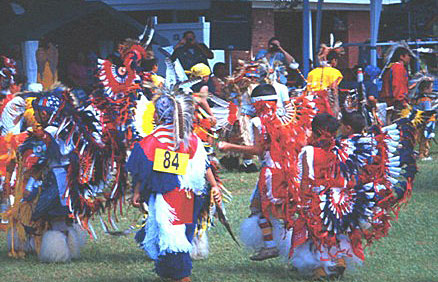
In their efforts to avoid removal and persecution and retain their way of life, the MOWA Choctaw may have hidden themselves too well. “I knew of the group as a child,” recalls UAB alumna Jacqueline Matte, who grew up in Washington County. “They were a group that was isolated. They were discriminated against because they were not white, and they weren’t allowed to go to either the white or the black schools. So most of them were illiterate, fearful, and suspicious of anyone, any outsider.”
Today, 80 percent of the tribe still lives below the poverty line, with the average household income being $6,250 according to the 2000 Census. But the MOWA have also made huge strides in reclaiming their Indian identity, cultural heritage, and pride after a century and a half of isolation. The tribe has vastly improved its quality of education, with its Calcedeaver Elementary School ranking third of the 778 schools in the State of Alabama’s Reading Initiative in 2005. The last fluent speakers of the Choctaw language passed away in the 1980s, but the tribe has instituted a revitalization program for its youth, connecting them to their heritage and keeping the language alive for future generations.
“If you go down to the reservation, you’re not going to find people with feathers going ‘woo-woo-woo,’” Cormier points out. “A lot of the ideas that people who aren’t familiar with Indians get from books and history aren’t accurate. That’s looking at the past, and they’re not frozen in time. A lot of their culture and traditions had to be hidden, and some of them were lost. And their culture and group identity has evolved over time, just like any group of people.”
The tribe preserves its past in its heritage museum, The MOWA Choctaw Cultural Center, which houses a research library and displays artifacts and historical materials. Also, every year on the third weekend of June the tribe holds a Pow Wow, which is open to the public and features traditional dancing, singing, feasting, contests, and games such as stickball, the Native American sport from which lacrosse was derived.
Some of the old traditions are still alive and well in everyday life, as well. A few women in the community still craft traditional handmade dresses and shirts, and many still employ the “three sisters” method of gardening with beans, squash, and maize. The Choctaw are a traditionally matrilineal society, which means they trace their kinship through females rather than males, and some still take the mother’s last name. The tradition also survives in the Mother of the Year award, which recognizes an exemplary female leader in the community. Additionally, a group still occasionally gathers on the land that they call “the old stomping grounds” to perform the traditional dances that have taken place on those same grounds for centuries.
“In anthropology, one of the most important things about culture is kinship,” says Cormier, “and that’s the most important thing to the MOWA. They have a long history of a few families that have lived together, worked together, know each other.”
The last five hundred years of exploitation and discrimination, up to and including their ongoing struggle for federal recognition, have left a deep impact on the MOWA. Nevertheless, the tribe remains resolute, confident, and ultimately comfortable in their own identity. Documents don’t define a people, after all. Family, memory, and culture do.
As the late Leon Taylor, a revered elder of the tribe, said in testimony to Congress in 1985, “Today, I am Choctaw. My mother was Choctaw. My grandfather was Choctaw. Tomorrow, I will still be Choctaw.”